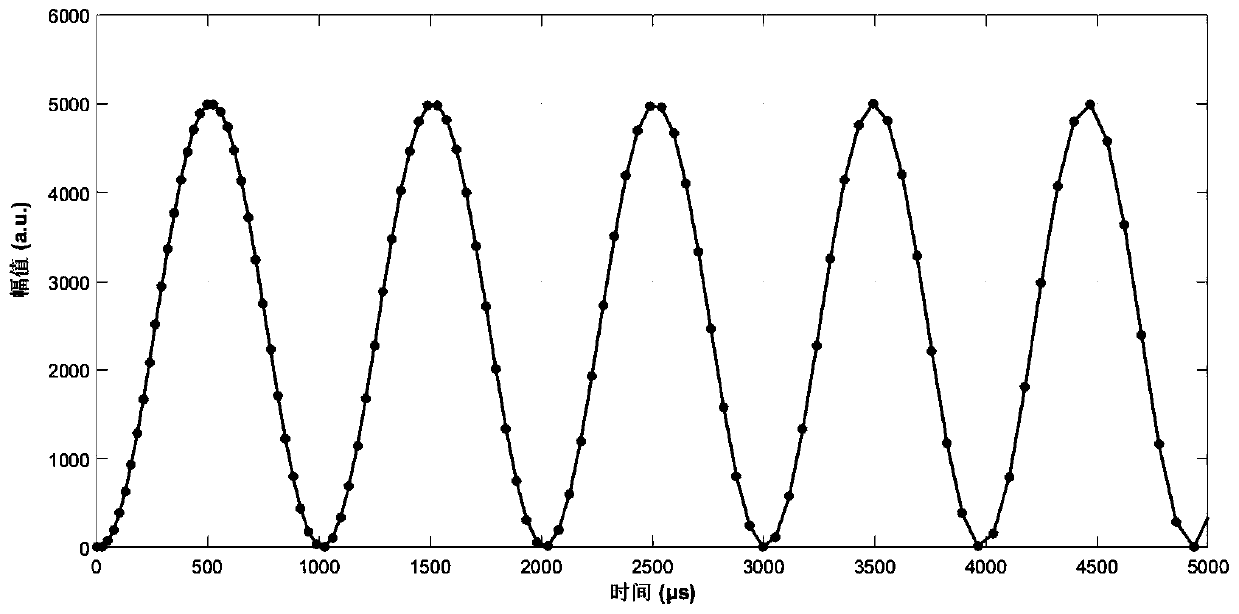A Correction Method for Eliminating the Nonlinearity of Semiconductor Laser FM Interference Signal
A technology of interference signal and correction method, applied in the direction of using optical devices, instruments, measuring devices, etc., can solve the problems of limited locking range of photoelectric phase-locked loop, limited range of linear frequency modulation, low precision of linear frequency modulation, etc., and achieves easy implementation and transformation. The effect of easy and improved measurement accuracy
- Summary
- Abstract
- Description
- Claims
- Application Information
AI Technical Summary
Problems solved by technology
Method used
Image
Examples
Embodiment 1
[0051] A correction method for eliminating the nonlinearity of a semiconductor laser frequency modulation interference signal, comprising the steps of:
[0052] Step 1: Assume that the mathematical expression of the ideal FM continuous wave interference beat frequency signal I(t) is:
[0053]
[0054] Here, T=1 / v b , determined by the optical path difference between the two frequency-modulated lasers.
[0055] When the laser light source has nonlinear frequency modulation, the frequency of the frequency modulation interference beat frequency signal also changes accordingly, so there is nonlinearity. Use the photodetector to convert the semiconductor laser frequency modulation interference optical signal into an analog electrical signal, and then filter, amplify and AD convert, the obtained beat frequency signal can be expressed by a quadratic polynomial, and the mathematical expression of the beat frequency signal at this time is:
[0056]
[0057] Here, I 0 is the si...
Embodiment 2
[0067] A correction method for eliminating the nonlinearity of a semiconductor laser frequency modulation interference signal, comprising the steps of:
[0068] Step 1: same as embodiment 1, obtain beat frequency signal mathematical expression as:
[0069]
[0070] Step 2: In this embodiment, the time-domain transformation formula can use third-order and higher-order N-order polynomials, and the corresponding modulation transformation coefficient is K 0 、K 1 ,...,K N , for N-order polynomials of third order and above, take the time position t corresponding to N+2 adjacent extreme points 1 , t 2 ,...,t N+2 , and establish the modulation transform coefficient K 0 、K 1 ,...,K N The N+1 linear equation system of
[0071]
[0072] Solving this system of linear equations, we can get K 0 、K 1 ,...,K N N+1 modulation transformation coefficients,
[0073] Step 3: Carry out time-domain transformation to the measured beat frequency signal according to the obtained modul...
Embodiment 3
[0075] A correction method for eliminating the nonlinearity of a semiconductor laser frequency modulation interference signal, comprising the steps of:
[0076] Step 1: same as embodiment 1, obtain beat frequency signal mathematical expression as:
[0077]
[0078] Step 2: In this embodiment, the time position t corresponding to N+2 extreme points can be selected by jumping 1 , t 2 ,...,t N+2 , that is, any two extreme points selected in sequence may not be adjacent, such as t i and t i+1 There are k-1 extreme points between the corresponding extreme points, then in the N+1 linear equation system, the corresponding modulation transformation coefficient K 0 、K 1 ,...,K N The linear equation for becomes:
[0079]
[0080] Other about the modulation transformation coefficient K 0 、K 1 ,...,K N The linear equation of , and so on, solve the corresponding linear equations to get K 0 、K 1 ,...,K N N+1 modulation transformation coefficients;
[0081] Step 3, accor...
PUM
 Login to View More
Login to View More Abstract
Description
Claims
Application Information
 Login to View More
Login to View More - R&D
- Intellectual Property
- Life Sciences
- Materials
- Tech Scout
- Unparalleled Data Quality
- Higher Quality Content
- 60% Fewer Hallucinations
Browse by: Latest US Patents, China's latest patents, Technical Efficacy Thesaurus, Application Domain, Technology Topic, Popular Technical Reports.
© 2025 PatSnap. All rights reserved.Legal|Privacy policy|Modern Slavery Act Transparency Statement|Sitemap|About US| Contact US: help@patsnap.com



